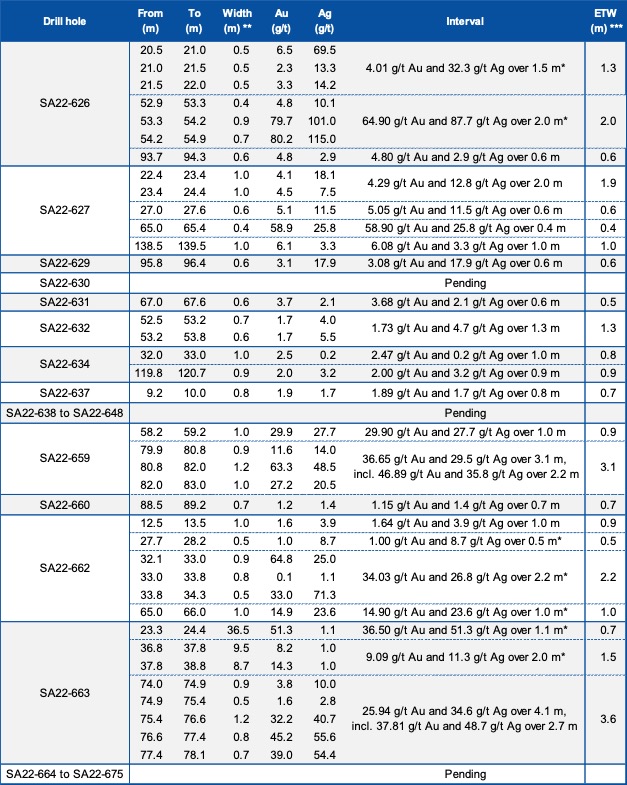Nicaragua – announced additional high-grade drill results from an area located approximately 50 meters (“m”) southwest of the current open pit mining operations at the San Albino West Pit in northern Nicaragua (the “SW Pit”). In 2022, a total of 13,284 m in 99 drill holes have been completed at the SW Pit. Most of the drilling intersected mineralization within, or immediately outside, the current permitted pit. Recent drilling has confirmed gold mineralization over an area of approximately 530 m x 600 m (strike x dip) compared to approximately 50 m x 50 m (see drill plan below) that was previously identified in the 2020 mineral resource estimate as the SW Pit.
36.65 g/t Au and 29.5 g/t Ag over 3.1 m (Estimated True Width – “ETW”) including 46.89 g/t Au and 35.8 g/t Ag over 2.2 m 25.94 g/t Au and 34.6 g/t Ag over 4.1 m (3.6m ETW) including 37.81 g/t Au and 48.7 g/t Ag over 2.7 m The objectives of the SW Pit drilling are to identify additional mineral resources and increase the overall size of San Albino Gold deposit within the currently permitted pit limits, and to test extensions of the mineralization beyond the pit limits.
Comprehensive drilling and detailed mapping of the area have identified multi-stage deformation events, with the latest represented by northeast to southwest faulting. The current interpretation indicates the faults may have displaced the vein in a manner that has upthrown blocks across the faults, bringing the mineralized zone closer to surface than the previous down dip projections indicated, increasing the potential for additional open pit mineral resources.
Akiba Leisman, CEO of Mako states: “The drill intercepts highlighted in this press release (including 36.65 g/t Au over 3.1 m ETW) are showing higher than average grade-thicknesses, at open pittable depths, at the edge of our permitted pit and directly underneath our mining contractor’s temporary workshop. As shown in the attached longitudinal section, the strike direction of this zone is open to the southwest, where, due to topography and the plunge of the mineralization, the vein is getting shallower in this direction. All intercepts are close to current infrastructure, and in some cases closer to the plant than where we are mining now. A drill rig is being positioned over 200 m further up-plunge to the southwest, which could significantly increase the scale of the SW Pit if continuity is proven.”
Drill hole SA22-659 intersected multiple intervals of high-grade, near surface gold mineralization, including 36.65 g/t Au and 29.5 g/t Ag over 3.1 m (ETW), 80 m below surface (see attached longitudinal section). This drill hole is collared approximately 58 m along strike from drill hole SA22-615 (see attached drill plan) which intersected 42.91 g/t Au and 38.3 g/t Ag over 4.50 m (4.1m ETW) 35.5 m from surface (see press release dated June 22, 2022). In addition, this hole intersected a mineralized interval grading 29.90 g/t Au and 27.7 g/t Ag over 1.0 m (0.9 m ETW), 58 m from the surface.
SA22-663, collared between the two drill holes mentioned above and approximately 30 m along strike from drill hole SA22-615, intersected multiple mineralized intervals (see table below), including 25.94 g/t Au and 34.6 g/t Ag over 4.1 m (3.6 m ETW), approximately 70 m below surface. The same drill hole intersected two, previously reported intervals grading 36.50 g/t Au and 51.3 g/t Ag over 1.10 m (0.7 m ETW) and 9.09 g/t Au and 11.3 g/t Ag over 2.0 m (1.5 m ETW), at vertical distances from surface of 22 m and 35 m, respectively. Both drill holes confirmed continuity of multiple high-grade gold bearing structures to the northeast along strike and indicate potential to further expand near surface mineral resources.
In addition, the Company received results for four drill holes from scout drilling at the San Albino North target which lies immediately to the north of the San Albino gold deposit straddling two concessions, San Albino-Murra and Potrerillos. Three drill holes intersected anomalous gold intervals, but below an internal cut-off grade (1.0 g/t Au). The other hole did not intersect any significant mineralized intervals.
Table 1: Assay Results Reported in This Press Release

Figure 1. San Albino Mine Drilling Program

Figure 2. Schematic Longitudinal Section

Drill core was continuously sampled from inception to termination of the entire drill hole. Sample intervals were typically one meter. Drill core diameter was HQ (6.35 centimeters). Geologic and geotechnical data was captured into a digital database, core was photographed, then one-half split of the core was collected for analysis and one-half was retained in the core library. Drill core samples were kept in a secured logging and storage facility until such time that they were delivered to the Managua facilities of Bureau Veritas and pulps were sent to the Bureau Veritas laboratory in Vancouver for analysis. Gold was analyzed by standard fire assay fusion, 30 gr aliquot, AAS finish. Samples returning over 10.0 g/t gold are analyzed utilizing standard Fire Assay-Gravimetric method. The Company follows industry standards in its QA&QC procedures. Control samples consisting of duplicates, standards and blanks were inserted into the sample stream at a ratio of 1 control sample per every 10 samples. Analytical results of control samples confirmed reliability of the assay data.
(Source: Press Releases – www.makominingcorp.com/news-media/press-releases/index.php?content_id=301)
Please send your press releases to press@miningnewspaper.com or juan.lamadrid@miningnewspaper.com